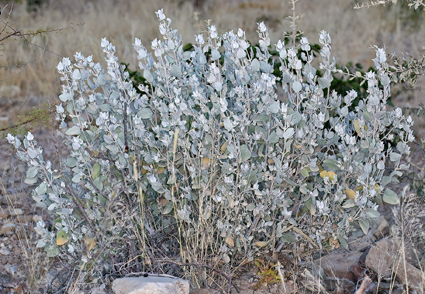Abstract
The name Petalidium ovatum is reinstated and an amplified description is provided for a species of Petalidium confined to Namibia. Petalidium ovatum used to be treated as a synonym of the widespread P. englerianum, but morphological characters support the reinstatement. Petalidium ovatum is a range-restricted species, only known from the Khorixas-Bergsig area in the Kaokoveld Centre of Endemism, northwestern Namibia, where it grows on arid hillsides and along ephemeral riverbeds and drainage lines. Diagnostic characters for P. ovatum include the pale grey, often almost white, appearance of the plants, vegetative parts with a dense white indumentum of both stellate and dendritic trichomes, flowers borne in short few-flowered dichasia, bracts oblanceolate with apices acute or obtuse, and bracteoles widely ovate. The flowers of P. ovatum are distinctive in having the anterior corolla lobe partly or completely yellow, the others burgundy, and with the two upper lobes connate towards the base for almost half their length. A comparison of some of the more prominent morphological features to differentiate Petalidium ovatum from P. englerianum, its morphologically most similar relative, is provided. Based on IUCN Red List categories and criteria, a conservation assessment of Least Concern (LC) is recommended for the reinstated species.
References
- Anderson, T. (1863) An enumeration of the species of Acanthaceae from the continent of Africa and the adjacent islands. Journal of the Proceedings of the Linnean Society. Botany 7 (25): 13–54. https://doi.org/10.1111/j.1095-8312.1863.tb01056.x
- Beentje, H. (2016) The Kew plant glossary: an illustrated dictionary of plant terms, 2nd ed. Kew Publishing, Kew, 184 pp.
- Clarke, C.B. (1899) Petalidium. In: Thiselton-Dyer, W.T. (Ed.) Flora of Tropical Africa 5 (1). L. Reeve & Co., London, pp. 87–93. https://doi.org/10.5962/bhl.title.42
- Craven, P. (2009) Phytogeographic study of the Kaokoveld Centre of Endemism. Ph.D. thesis. University of Stellenbosch, Stellenbosch, 234 pp.
- Darbyshire, I., Kiel, C.A., Astroth, C.M., Dexter, K.G., Chase, F.M. & Tripp, E.A. (2020) Phylogenomic study of Monechma reveals two divergent plant lineages of ecological importance in the African savanna and succulent biomes. Diversity 12 (6): a237 [25 pp]. https://doi.org/10.3390/d12060237
- Edwards, D. & Leistner, O.A. (1971) A degree reference system for citing biological records in southern Africa. Mitteilungen der Botanischen Staatssammlung München 10: 501–509. [https://biostor.org/reference/185348]
- Germishuizen, G. & Meyer, N.L. (Eds.) (2003) Plants of southern Africa: an annotated checklist. Strelitzia 14. National Botanical Institute, Pretoria, 1231 pp.
- Glen, H.F. & Germishuizen, G. (Comp.) (2010) Botanical exploration of southern Africa, 2nd edn. Strelitzia 26. South African National Biodiversity Institute, Pretoria, 489 pp. https://doi.org/10.5962/bhl.title.145034
- IUCN (2012) IUCN red list categories and criteria: Version 3.1. 2nd edn. Gland, Switzerland and Cambridge U.K., iv + 32 pp.
- Loiseau, O., Manzitto, E.A., Swanepoel, W. & Dexter, K.G. (2023) Net diversification rates of the woody plant genus Petalidium (Acanthaceae) are highest in the ancient and arid Namib Desert. Frontiers in Ecology and Evolution 11: 1–10. https://doi.org/10.3389/fevo.2023.1193728
- Manktelow, M. (2000) The filament curtain: a structure important to systematics and pollination biology in the Acanthaceae. Botanical Journal of the Linnean Society 133 (2): 129–160. https://doi.org/10.1111/j.1095-8339.2000.tb01539.x
- McNeill, J. (2014) Holotype specimens and type citations: general issues. Taxon 63 (5): 1112–1113. https://doi.org/10.12705/635.7
- Mendelsohn, J., Jarvis, A., Roberts, C. & Robertson, T. (2002) Atlas of Namibia. Philip, Cape Town, 200 pp.
- Meyer, P.G. (1968) Acanthaceae. Prodromus einer Flora von Südwestafrica 130: 1–65.
- Nees von Esenbeck, C.G. (1832) Acanthaceae India Orientalis. In: Wallich, N. (Ed.) Plantae Asiaticae rariores: or descriptions and figures of a select number of unpublished East Indian plants, vol. 3. Treuttel & Würtz, London, pp. 41–117. https://doi.org/10.5962/bhl.title.468
- Obermeijer, A.A. (1936) The South African species of Petalidium. Annals of the Transvaal Museum 18: 151–162.
- Schinz, H. (1890) Beiträge zur Kenntnis der Flora von Deutsch-Südwest-Afrika und der angrenzenden Gebiete: IV. Verhandlungen des Botanischen Vereins für die Provinz Brandenburg 31: 179–230. Available from: https://www.biodiversitylibrary.org/item/104936#page/269/mode/1up (accessed 22 Nov. 2023)
- Schinz, H. (1916) Beiträge zur Kenntnis der afrikanishen Flora XXVII. Vierteljahrsschrift der Naturforschenden Gesellschaft in Zürich 61: 431–464. Available from: https://www.biodiversitylibrary.org/item/101474#page/465/mode/1up (accessed 22 Nov. 2023)
- Suessenguth, K. & Merxmüller, H. (1955) Taxa praecipue Africana. Mitteilungen der Botanischen Staatssammlung München 2: 67–83. Available from: https://www.biodiversitylibrary.org/item/52336#page/93/mode/1up (accessed 22 Nov. 2023)
- Swanepoel, W. (2020) Petalidium kaokoense (Acanthaceae), a new species from Namibia. Phytotaxa 468 (3): 236–242. https://doi.org/10.11646/phytotaxa.468.3.1
- Swanepoel, W. & Manzitto-Tripp, E.A. (2022) Petalidium sesfonteinense (Acanthaceae), a new species from the Kaokoveld, Namibia. Phytotaxa 549 (2): 127–135. https://doi.org/10.11646/phytotaxa.549.2.1
- Swanepoel, W., Nanyeni, L. & Van Wyk, A.E. (2022) Petalidium mannheimerae (Acanthaceae), a new species from Namibia and South Africa with notes on the taxonomic identity of Petalidium parvifolium. Phytotaxa 561 (1): 1–13. https://doi.org/10.11646/phytotaxa.561.1.1
- Swanepoel, W. & Van Wyk, A.E. (2023a) Petalidium konkiepense (Acanthaceae), a new species from Namibia. Phytotaxa 585 (1): 29–38. https://doi.org/10.11646/phytotaxa.585.1.3
- Swanepoel, W. & Van Wyk, A.E. (2023b) Petalidium karasbergense (Acanthaceae), a new species from Namibia. Phytotaxa 609 (1): 1–9. https://doi.org/10.11646/phytotaxa.609.1.1
- Thiers, B.M. (2023) Index Herbariorum: a global directory of public herbaria and associated staff. New York Botanical Garden’s Virtual Herbarium. Available from: http://sweetgum.nybg.org/ih/ (accessed September 2023)
- Tripp, E.A. & Dexter, K.G. (2012) Taxonomic novelties in Namibian Ruellia (Acanthaceae). Systematic Botany 37 (4): 1023–1030. https://doi.org/10.1600/036364412X656509
- Tripp, E.A., Tsai, Y.E., Zhuang, Y. & Dexter, K.G. (2017) RADseq dataset with 90% missing data fully resolves recent radiation of Petalidium (Acanthaceae) in the ultra-arid deserts of Namibia. Ecology and Evolution 7 (19): 1–17. https://doi.org/10.1002/ece3.3274
- Turland, N.J., Wiersema, J.H., Barrie, F.R., Greuter, W., Hawksworth, D.L., Herendeen, P.S., Knapp, S., Kusber, W.-H., Li, D.-Z., Marhold, K., May, T.W., McNeill, J., Monro, A.M., Prado, J., Price, M.J. & Smith, G.F. (2018) International Code of Nomenclature for algae, fungi, and plants (Shenzhen Code) adopted by the Nineteenth International Botanical Congress Shenzhen, China, July 2017. Regnum Vegetabile 159. Koeltz Botanical Books, Glashütten. https://doi.org/10.12705/Code.2018
- Urban, I. (1916) Geschichte des Königlichen Botanischen Museums zu Berlin-Dahlem (1815-1913) nebst aufzählung soiner Sammlungen. C. Heinrich, Dresden, 456 pp.
- Van Wyk, A.E. & Smith, G.F. (2001) Regions of floristic endemism in southern Africa: a review with emphasis on succulents. Umdaus Press, Hatfield, Pretoria, 199 pp.


